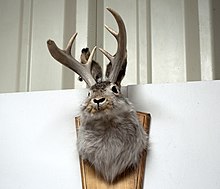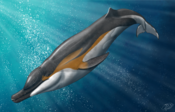Wikipedia:WikiProject Tree of Life/Newsletter/016

- September 2021—Issue 016
- Tree of Life
- Welcome to the Tree of Life newsletter!
|
|
|
|
| Hoax taxon sniffed out after nearly fifteen years |
|
Cross posted from the Signpost  On August 7, WikiProject Palaeontology member Rextron discovered a suspicious taxon article, Mustelodon, which was created in November 2005. The article lacked references and the subsequent discussion on WikiProject Palaeontology found that the alleged type locality (where the fossil was first discovered) of Lago Nandarajo "near the northern border of Panama" was nonexistent. In fact, Panama does not even really have a northern border, as it is bounded along the north by the Caribbean Sea. No other publications or databases mentioned Mustelodon, save a fleeting mention in a 2019 book that presumably followed Wikipedia, Felines of the World. The article also appeared in four other languages, Catalan, Spanish, Dutch, and Serbian. In Serbian Wikipedia, a note at the bottom of the page warned: "It is important to note here that there is no data on this genus in the official scientific literature, and all attached data on the genus Mustelodon on this page are taken from the English Wikipedia and are the only known data on this genus of mammals, so the validity of this genus is questionable." Editors took action to alert our counterparts on other projects, and these versions were removed also. As the editor who reached out to Spanish and Catalan Wikipedia, it was somewhat challenging to navigate these mostly foreign languages (I have a limited grasp of Spanish). I doubted that the article had very many watchers, so I knew I had to find some WikiProjects where I could post a machine translation advising of the hoax, and asking that users follow local protocols to remove the article. I was surprised to find, however, that Catalan Wikipedia does not tag articles for WikiProjects on talk pages, meaning I had to fumble around to find what I needed (turns out that WikiProjects are Viquiprojectes in Catalan!) Mustelodon remains on Wikidata, where its "instance of" property was swapped from "taxon" to "fictional taxon". How did this article have such a long lifespan? Early intervention is critical for removing hoaxes. A 2016 report found that a hoax article that survives its first day has an 18% chance of lasting a year.[1] Additionally, hoax articles tend to have longer lifespans if they are in inconspicuous parts of Wikipedia, where they do not receive many views. Mustelodon was only viewed a couple times a day, on average. Mustelodon survived a brush with death three years into its lifespan. The article was proposed for deletion in September 2008, with a deletion rationale of "No references given; cannot find any evidence in peer-reviewed journals that this alleged genus actually exists". Unfortunately, the proposed deletion was contested and the template removed, though the declining editor did not give a rationale. Upon its rediscovery in August 2020, Mustelodon was tagged for speedy deletion under CSD G3 as a "blatant hoax". This was challenged, and an Articles for Deletion discussion followed. On 12 August, the AfD was closed as a SNOW delete. WikiProject Palaeontology members ensured that any trace of it was scrubbed from legitimate articles. The fictional mammal was finally, truly extinct. At the ripe old age of 14 years, 9 months, this is the longest-lived documented hoax on Wikipedia, topping the previous documented record of 14 years, 5 months, set by The Gates of Saturn, a fictitious television show, which was incidentally also discovered in August 2020. How do we discover other hoax taxa? Could we use Wikidata to discover taxa are not linked to databases like ITIS, Fossilworks, and others?
|
| Spotlight with Mattximus |
 This month's spotlight is with Mattximus, author of two Featured Articles and 29 Featured Lists at current count.
I think I have a compulsion to make lists, it doesn't show up in my real life, but online I secretly get a lot of satisfaction making orderly lists and tables. It's a bit of a secret of mine, because it doesn't manifest in any other part of my life. My background is in biology, so this was a natural (haha) fit.
This experiment was just to see if I could get any random article to FA status, so I picked the very first alphabetical animal species according to the taxonomy and made that attempt. Technically, there isn't enough information for a species page so I just merged the species into a genus and went from there. It was a fun exercise, but doing it alone is not the most fun so it's probably on pause for the foreseeable future. Note: Aporhynchus is the first alphabetical taxon as follows: Animalia, Acanthocephala, Archiacanthocephala, Apororhynchida, Apororhynchidae, Apororhynchus
I would recommend getting a good article nominated, then a featured list up before tackling the FA. Lists are a bit more forgiving but give you a taste of what standards to expect from FA. The most time consuming thing is proper citations so make sure that is in order before starting either.
My personality in real life does not match my wikipedia persona. I'm not a very organized, or orderly in real life, but the wikipedia pages I brought to FL or FA are all very organized. Maybe it's my outlet for a more free-flowing life as a scientist/teacher.
The fact that wikipedia exists free of profit motive and free for everyone really is something special and I encourage everyone to donate a few dollars to the cause. |
| August DYKs |
|
You are receiving this because you added your name to the subscribers list of the WikiProject Tree of Life. If you no longer wish to receive the newsletter, please remove your name.




